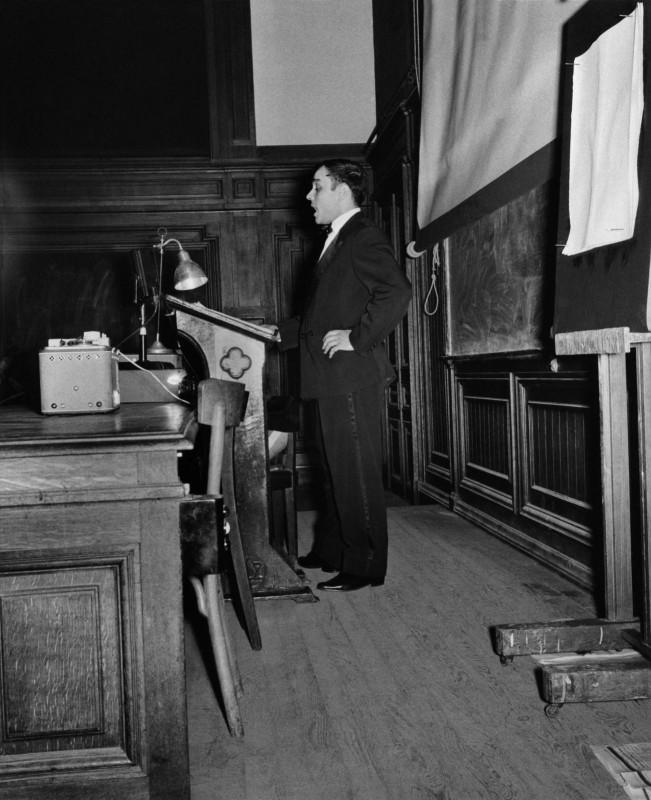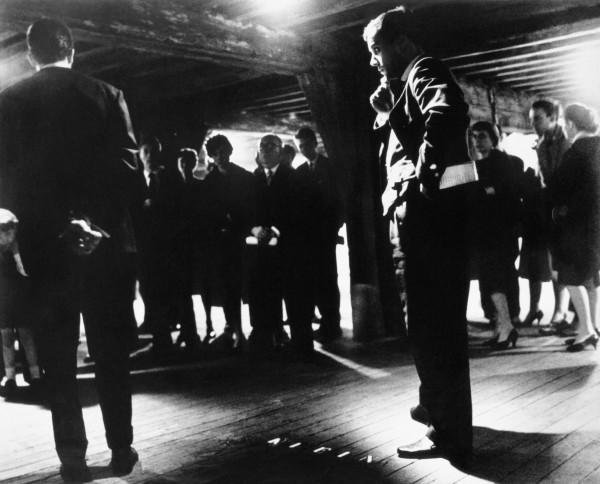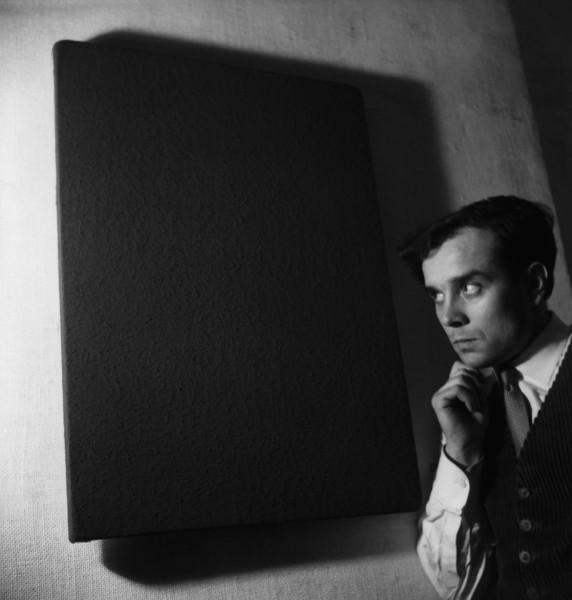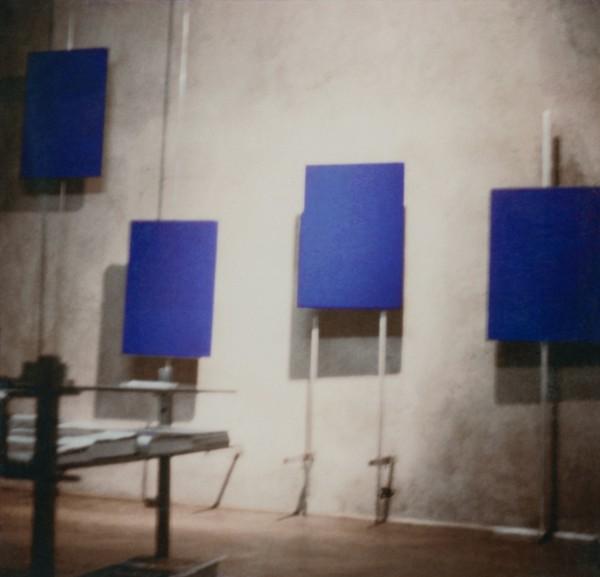Throughout his career, according to him, Yves Klein was "in search of the real value of the painting". The term "value" here suggests not only the colour nuance - the famous I.K.B. blue - or the artistic merit of the work, but also the commercial value, the exchange price. From exhibition to exhibition, from speculative discourse to artistic innovation, his career has been punctuated by the ceaseless quest for the 'right price' - the price that would do justice to the artistic merit of the work, deliver it to the market without subjecting it to its own contingency and arbitrariness, and offer it for exchange without reducing it to the status of a mere commodity. Using the example of three exhibitions (Milan, 1957; London, 1957; Antwerp, 1959), we will trace the development of Klein's thinking on the problem of price, and the stages that led him, in 1959, to propose the "Outline" of a new "economic system", better able to fulfil its function of evaluation.
Klein at the Galerie Apollinaire: Intrinsic Value and the Right Price
On 2 January 1957, at the Galerie Apollinaire in Milan, Yves Klein opened an exhibition of eleven of his works. All were perfectly identical: monochromes of the same format, painted on a roller in the same ultramarine blue. However, according to Klein's fable, these canvases were displayed and each sold for a different price. The anecdote is fictional: several articles from the period mention a single price of 25,000 lire per painting. But what lessons can be drawn from this "didactic fable"? The first lesson is stated by Klein himself: "the pictorial quality of each painting is perceptible by something other than its material and physical appearance". Does this mean that value is independent of the painting? No, recognising the inadequacy of appearance to justify differences in quality does not lead Klein to relativism, to the affirmation of the subjective nature of value or its dependence on an institutional context. Value may be invisible, but it is nonetheless lodged at the very heart of the object, in its concrete materiality. Klein thus tends to reintroduce the medieval notion of the 'just price': there is a divine order of values, to which the price, the human instrument of exchange, must conform. Value is therefore intrinsic, and price derived: according to the economist Alfred de Tarde, the idea of the 'just price': there is a divine order of values, to which price, the human instrument of exchange, must conform . According to the economist Alfred de Tarde, the idea of the "fair price" implies that "price and value are the same thing", "they are incorporated into the object; they cannot rise or fall without the object changing materially". Unlike the contingent market price, the fair price is therefore objective and normative. When he claims to impose different prices on apparently identical paintings, Klein chooses to attribute, despite the rules of the market, a price that reflects the real value of the works, a power that only he is worthy of judging; a power that, if he does not really hold, he can at least attribute to himself in the fable.
Klein at Galerie One: Value and market price
A few months after the Milan exhibition, in the summer of 1957, Klein exhibited in London at the One gallery. The critical reception of this exhibition marked a new stage in Klein's thinking about price. Almost without exception, all the articles focused their criticism on this question. What was shocking was not so much that these works of art could exist, but that they could be sold, and therefore bought. Prices are mentioned almost systematically. It often forms the title or subtitle of the article, and is highlighted by the typography. The prices quoted in the articles are almost always fanciful. What matters is not so much the exact amount of the price as its enormity in relation to the supposed value of the works, or even the very existence of a price. It seems that the artist himself is to some extent behind this reaction. A document made available to visitors by Galerie One details the artist's previous sales, and their prices. "One concrete proof that Klein's painting is taken seriously", explains the text, "is that he manages to make a living from his art". The strategy is almost naïve, so obvious is it: to sell is to give a guarantee of his seriousness, his good faith, his quality.
Klein in Antwerp: developing a new "economic system
For Klein, therefore, price was not simply of secondary importance, resulting from intrinsic value: as the crystallisation of the act of exchange, it was crucial if the work was to take place, if it was to be recognised as a work. Between the Milan and London exhibitions, the development of intangible art deepened this reflection: the sale became the only manifestation of the work. This raises a problem: if price reflects value, then the price of a priceless work of art should be unaffordable. Yet the act of selling is essential to the validation of the work as a work, to its very existence. This contradiction came to the fore at a group exhibition in Antwerp in 1959. For the first time, Klein refused to sell an immaterial work for money, and demanded "a kilo of pure gold" in exchange. Mallarmé had already written in 1889 that "to want to assign its real price, in money, to a work of art, is to insult it", and Klein understood this well during his exhibition in London. The only solution then is to abandon monetary exchange, which devalues the work by giving it a banal price in money, in favour of a form of barter, which allows the exchange to take place while preserving the purity of the work. This is what Klein theorises in his text "Sketch and Outline of the Economic System of the Blue Revolution", a veritable presentation of a utopian economic system in which exchange would regain its true value. At a time in history when the very notion of a monetary standard is disappearing from the world economy, leaving currencies floating, Klein "rejects reserves and currencies", and proposes a new standard for exchange: the work of art, which would replace gold in the vaults of the Central Bank. In this system, works of art would have no price, since they would be the measure of all prices; they would be at the heart of every exchange without ever being left to the vagaries of the market. The monogold entitled Valeur or (Gold Value) remains as a trace of this utopian idea of removing art from economic contingencies to make it the standard, the measure and the absolute of all value and all exchange.
Sophie Cras
Arts & Societies research seminar
Sophie Cras is a graduate of Sciences Po (2008, Master's in Finance) and has a Master's in art history (2009). She is currently a doctoral student in art history at the University of Paris I. She is also preparing for her degree at the École normale supérieure on rue d'Ulm, in the History and Theory of the Arts department.



